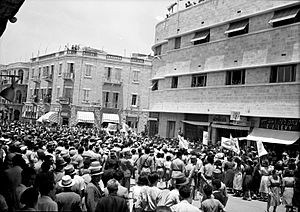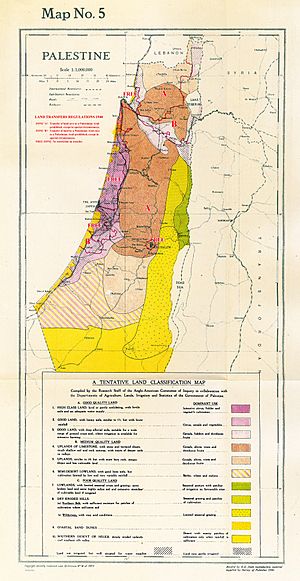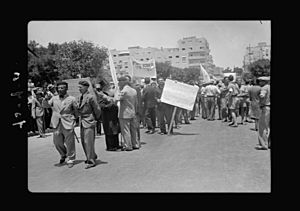White Paper of 1939 facts for kids
Quick facts for kids White Paper of 1939 |
|
| Created | May 1939 |
| Ratified | 23 May 1939 |
| Purpose | Statement of British policy in Mandatory Palestine |
The White Paper of 1939 was an important policy document created by the British government. It was led by Prime Minister Neville Chamberlain. This paper was a response to the 1936–1939 Arab revolt in Palestine, a major uprising.
After the British Parliament approved it on May 23, 1939, it became the main rulebook for Mandatory Palestine. This was the name for the area that is now Israel, the West Bank, and Gaza, which was controlled by Britain after World War I. The White Paper guided British policy there until Britain left in 1948. After the war, the future of Palestine was discussed by the United Nations.
The British government wrote this policy on its own. This happened after a meeting called the London Conference failed. This meeting tried to get Arab and Jewish leaders to agree, but they couldn't.
The White Paper suggested creating an independent Palestinian state within 10 years. This state would include a Jewish national home. It rejected an earlier idea from the Peel Commission to divide Palestine into two separate states.
The paper also set limits on Jewish immigration. Only 75,000 Jewish people could move to Palestine over the next five years. After that, any more immigration would need the approval of the Arab majority. It also restricted Jewish people from buying land from Arabs in most areas of Palestine.
Arab leaders in Palestine, especially those influenced by Amin al-Husseini, officially rejected the White Paper. They felt it did not meet their demands. However, some more moderate Arab groups were willing to accept it.
Jewish groups in Palestine immediately rejected the White Paper. They started protests and attacks on government property. These actions lasted for several months. On May 18, a general strike was called by Jewish groups.
Some parts of the White Paper, like the rules on land sales and immigration limits, were put into action. By 1944, only 51,000 of the 75,000 immigration spots had been used. So, Britain allowed immigration to continue at a rate of 1,500 people per month. This continued until the remaining spots were filled. From December 1945 until 1948, 1,500 more immigration certificates were given out each month. However, some key parts of the White Paper were never fully carried out. This was partly due to changes in the British government and later because of World War II.
Contents
How It All Started
During World War I, Britain made two important promises about the Middle East. First, they promised the Arab leaders of Arabia independence for a united Arab country in Syria. This was in exchange for Arab support against the Ottoman Empire. Britain hoped this alliance would prevent a large Muslim uprising in their territories.
Second, Britain also made a secret deal with France, called the Sykes–Picot Agreement. This plan was to divide the Middle East between them.
Later, in 1917, Britain made another promise called the Balfour Declaration. This promised to help create a Jewish national home in Palestine. This was partly to gain Jewish support in Europe. Both the idea of a Jewish homeland and Arab self-determination were approved at the San Remo Conference.
In 1922, the League of Nations approved the Palestine Mandate. This document clearly stated Britain's duties in Palestine. These duties included helping to create a Jewish national home. It also said Britain must protect the rights of all people living in Palestine.
However, the Emirate of Transjordan (which is now Jordan) was excluded from the rules about Jewish settlement. This was decided in September 1922. Strong Arab opposition to Jewish immigration led Britain to limit it. They decided immigration should depend on how well the country's economy could support new people. This meant annual limits were set. But, Jewish people with a lot of money (£500) could still enter freely.
After Adolf Hitler came to power in Germany, many European Jews wanted to leave. The 1935 Nuremberg Laws took away citizenship from 500,000 German Jews. It was hard for Jews to move money out of Germany. But, the Jewish Agency made a deal. This deal allowed Jews in Germany to buy German goods for export to Palestine. This helped them get around the money restrictions.
The large number of Jewish people entering Palestine led to the 1936–1939 Arab revolt in Palestine. Britain responded by sending a special group, the Peel Commission, to study the problems. In 1937, the Peel Commission suggested dividing Palestine into two states: one Arab and one Jewish. The Arabs rejected this plan. Jewish leaders gave a mixed response. The violence continued.
In 1938, another group, the Woodhead Commission, looked into how to divide Palestine. They decided it would be too difficult. This was because it would require moving many Arabs by force, which Britain did not want to do. The British government then said that dividing Palestine was not practical. They suggested a much smaller Jewish state, only along the coast.
At the same time, the Évian Conference in July 1938 failed to find a solution for the growing number of Jewish refugees. This put more pressure on Britain to solve the issue of Jewish immigration to Palestine.
London Conference
In February 1939, Britain held the London Conference. The goal was to reach an agreement between Arabs and Jews in Palestine. Arab delegates agreed to attend only if they didn't have to meet directly with Jewish representatives. They felt this would mean recognizing Jewish claims. So, Britain held separate meetings with each side. The conference ended without success on March 17.
As World War II was approaching, Britain believed it had Jewish support already. But, they were worried about angering the Arab world. Countries like Egypt, Iraq, and Saudi Arabia were independent and allied with Britain. This made keeping Arab support very important for British policy.
What the White Paper Said
The White Paper had three main sections:
- Section I. The Constitution: This part said that the promise of a "national home for the Jewish people" had been met. This was because over 450,000 Jewish people had already settled in Palestine. It also called for an independent Palestine to be created within 10 years. This new state would be governed by both Arabs and Jews working together.
The paper clearly stated that Palestine would not become a Jewish state against the will of the Arab people. It said that the goal was to create an independent Palestinian state within 10 years. This state would have special agreements with the United Kingdom. These agreements would cover trade and military needs. The independent state would be one where Arabs and Jews shared power. This would ensure that the important interests of both groups were protected.
- Section II. Immigration: This section limited Jewish immigration to Palestine. Only 75,000 Jewish people would be allowed to move there over the next five years. After that, no more Jewish immigration would be allowed unless the Arabs of Palestine agreed to it.
The British government believed that unlimited immigration was not needed for a Jewish National Home. They said that too much immigration could harm the economy and cause serious political problems. The fear among Arabs that Jewish immigration would continue forever had caused much trouble. This fear led to violence and made life unsafe for everyone. The paper said that if immigration continued without limits, it would create lasting hatred between Arabs and Jews.
It explained that 10,000 Jewish immigrants would be allowed each year for five years. If fewer came one year, the remaining spots could be added to later years. Also, 25,000 refugees would be allowed in. This was to help with the Jewish refugee problem. Special care would be given to refugee children. The British High Commissioner would decide how many people the country could support. Arab and Jewish representatives would be asked for their opinions before decisions were made.
- Section III. Land: Before the White Paper, there were no limits on Arabs selling land to Jews. But the paper now said that this needed to change.
Many reports showed that the Arab population was growing. Also, a lot of Arab land had been sold to Jews. This meant that in some areas, there was no more land for sale. In other areas, land sales had to be limited. This was to make sure Arab farmers could keep their way of life. It also prevented a large number of Arabs from losing their land. So, the High Commissioner was given powers to stop or control land sales.
How People Reacted
Parliamentary Approval
On May 22, 1939, the House of Commons debated the White Paper. Some members argued it went against the original Mandate. But, the motion to reject it was defeated. The next day, the House of Lords accepted the new policy without a vote.
During the debate, Lloyd George called the White Paper an "act of perfidy" (a betrayal). Winston Churchill also voted against his own party, even though they were in government. Some government members, including the Jewish Secretary of State for War Leslie Hore-Belisha, voted against the plan or didn't vote at all. They felt it went against the Balfour Declaration.
League of Nations
The Permanent Mandates Commission, a group that oversaw the Mandates, said the White Paper went against how the Mandate had been understood before. Four members felt the policy was not in line with the Mandate. Three others thought the situation might justify the policy if the League of Nations Council didn't object. But, World War II started soon after, stopping further discussions.
Arab Reactions
The Arab Higher Committee first argued that the promise of an independent Palestine was not real. They felt that Jewish people could stop the government from working by refusing to take part. They also thought that British officials would still have the real power. They also believed the limits on Jewish immigration were not enough. They wanted a complete stop to Jewish immigration and an end to the Jewish national home policy.
In June 1939, Hajj Amin al-Husayni surprised others by rejecting the White Paper. Some historians believe he did this because the plan did not put him in charge of the future Palestinian state. However, in July 1940, some Palestinian Arab leaders, including Jamal al-Husseini, later agreed to the White Paper's terms.
Zionist Reactions

Zionist groups in Palestine immediately rejected the White Paper. They started attacking government property and Arab civilians. This lasted for several months. On May 18, a Jewish general strike was called.
Even before the White Paper, in February 1939, the Irgun, a right-wing Zionist group, carried out bombings. These attacks killed many Arabs. This was in response to Arab celebrations after reports that Britain might grant independence to Palestine.
After the White Paper, the Irgun started planning a rebellion. Their goal was to remove the British and create an independent Jewish state. Their leader, Ze'ev Jabotinsky, suggested a plan for a revolt in October 1939. This plan involved him and others secretly arriving in Palestine. Then, the Irgun would attack and take over British government buildings. They would raise the Jewish flag and hold the buildings for at least 24 hours. At the same time, Zionist leaders in Europe and the United States would declare an independent Jewish state. The Irgun considered this plan seriously but worried about the many lives it would cost.
Another Irgun leader, Avraham Stern, planned for 40,000 armed Jewish fighters from Europe to come to Palestine and join the rebellion. The Polish government even supported his plan and began training Jews and preparing weapons for them. However, World War II started in September 1939, stopping these plans.
After the war began, David Ben-Gurion, the head of the Jewish Agency for Palestine, made a famous statement. He said, "We will fight the White Paper as if there is no war, and fight the war as if there is no White Paper." This meant they would oppose the White Paper's policies while also supporting the war effort against Nazi Germany.
What Happened Next
On July 13, the British stopped all Jewish immigration to Palestine until March 1940. They said this was because of an increase in illegal immigrants.
In March 1940, the British High Commissioner for Palestine divided Palestine into three zones for land sales:
- In Zone A (about 63% of the country), land could generally not be sold to anyone who was not a Palestinian Arab.
- In Zone B (about 32% of the country), sales from a Palestinian Arab to anyone other than another Palestinian Arab were very limited. The High Commissioner had to approve them.
- In the remaining 5% of Palestine (which included the most fertile areas), land sales were not restricted.
In December 1942, when the world learned about the mass killing of Jews (the Holocaust), there were 34,000 immigration certificates left. In February 1943, the British government announced that these certificates could be used to rescue Jewish children from Southeastern Europe. This plan had some success. However, many who received certificates could not emigrate. In July, it was announced that any Jewish refugee who reached a neutral country could get clearance for Palestine. By the end of the war, only 3,000 certificates were left.
After World War II, the British Labour Party voted to cancel the White Paper and create a Jewish state in Palestine. However, the party's Foreign Minister, Ernest Bevin, continued the policy. It stayed in effect until Britain left Palestine in May 1948.
After the war, many Holocaust survivors desperately wanted to reach Palestine. This led to a large amount of illegal Jewish migration. Britain tried to stop this, which led to violent resistance from Jewish underground groups.
Illegal immigrants caught by the British were sent to camps on Cyprus. These immigrants had no citizenship and could not be sent back to any country. Many children and orphans were among those held in these camps.
By December 1945, immigration numbers, including illegal immigrants, had gone slightly over the White Paper's limit. On January 31, 1946, the High Commissioner announced that Britain would continue to allow 1,500 Jewish immigrants per month. Priority would be given to European Jews with special claims, like those with relatives already in Palestine. Illegal immigrants would still be counted against these quotas. This quota continued until the end of the British Mandate.
When Israel declared its independence, one of its first actions was to cancel all laws from the 1939 White Paper. This included the rules about immigration and land sales.
See also




